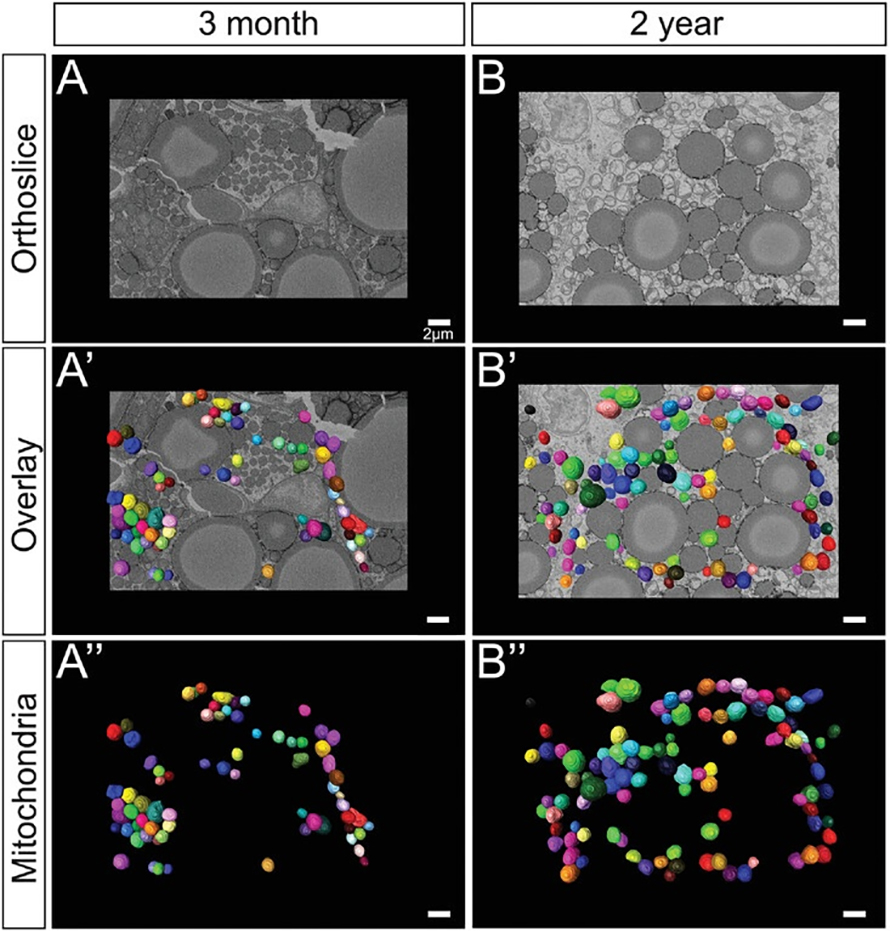Hinton lab maps structure of mitochondria at different life stages
Mitochondria, organelles with an inner and outer membrane, are responsible for creating the energy that cells use to survive, and their morphology is key to accomplishing this task. The inner mitochondrial membrane contains folds, called cristae, that maximize the surface area available for mitochondrial energetic processes.
Although oxidative stress is a normal part of the reactions that take place inside mitochondria, excess stress and dysfunction are associated with disease and aging. Yet, as the number and function of mitochondria are highly dependent on what tissue they’re in, scientists are interested in exploring the changes that occur in mitochondria across tissues as we age.

The lab of Antentor O. Hinton Jr., assistant professor of molecular physiology and biophysics, came together with collaborators from across Vanderbilt University, Vanderbilt University Medical Center, the U.S., and Brazil to determine the differences in the 3D morphology of mitochondria and their cristae in brown adipose tissue.
BAT uses the cristae within mitochondria for thermogenesis—the dissipation of heat that helps humans classify as warm-blooded animals. Scientists have observed a decrease in BAT thermogenic function in both older rodents and humans, and the decline has been associated with the development of metabolic disorders, including obesity and diabetes.
Changes in mitochondrial morphology in the context of BAT is not well understood, so researchers, led by Hinton lab Ph.D. student Amber Crabtree, developed a quantitative 3D electron microscopy approach to map cristae network organization in the BAT of adult and aged mice.
The researchers’ findings, published in Advanced Biology and featured on the cover in January, build upon prior work that suggests that the surface area, volume, and complexity of mitochondria grow as mice age. However, Crabtree and Hinton also showed that the surface area, volume, and complexity of the cristae decrease during aging.
“These findings highlight the importance of considering changes in overall cristae density and not relying solely on changes in mitochondrial mass to quantify mitochondrial morphology changes,” the authors said in the paper.
The researchers also reported that the overall shape of mitochondria influences the thermogenic capacity of BAT, as high-thermogenic BAT mitochondria were round or spherical, while low-thermogenic mitochondria were more elongated. Reduced thermogenic capacity was also associated with aging and obesity, which suggests that mitochondrial structure and function may have implications for overall metabolic health.

Hinton hopes that future studies will determine whether there are sex-dependent differences in BAT mitochondrial structure across aging. Specifically, probing mitochondrial structure and function within BAT and across other tissues and other species may broaden our understanding of aging mechanisms and identify potential therapies to treat ailments associated with aging and mitochondrial dysfunction.
Collaborators on this paper include labs from Vanderbilt University, Vanderbilt University Medical Center, Meharry Medical College, Fisk University, Tennessee State University, the University of Pittsburgh, the National Heart, Lung and Blood Institute, the University of Washington, the Federal University of State of Rio de Janeiro, and the Catholic University of Petrópolis.
Enjoy reading ASBMB Today?
Become a member to receive the print edition four times a year and the digital edition monthly.
Learn moreGet the latest from ASBMB Today
Enter your email address, and we’ll send you a weekly email with recent articles, interviews and more.
Latest in Science
Science highlights or most popular articles

Mining microbes for rare earth solutions
Joseph Cotruvo, Jr., will receive the ASBMB Mildred Cohn Young Investigator Award at the ASBMB Annual Meeting, March 7–10, just outside of Washington, D.C.

Fueling healthier aging, connecting metabolism stress and time
Biochemist Melanie McReynolds investigates how metabolism and stress shape the aging process. Her research on NAD+, a molecule central to cellular energy, reveals how maintaining its balance could promote healthier, longer lives.

Mapping proteins, one side chain at a time
Roland Dunbrack Jr. will receive the ASBMB DeLano Award for Computational Biosciences at the ASBMB Annual Meeting, March 7–10, just outside of Washington, D.C.

Exploring the link between lipids and longevity
Meng Wang will present her work on metabolism and aging at the ASBMB Annual Meeting, March 7-10, just outside of Washington, D.C.

Defining a ‘crucial gatekeeper’ of lipid metabolism
George Carman receives the Herbert Tabor Research Award at the ASBMB Annual Meeting, March 7–10, just outside of Washington, D.C.

The science of staying strong
Muscles power every movement, but they also tell the story of aging itself. Scientists are uncovering how strength fades, why some species resist it and what lifestyle and molecular clues could help preserve muscle health for life.

